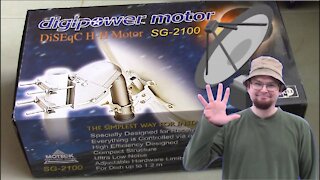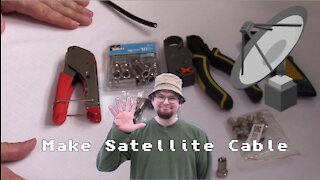Premium Only Content

Solid VS Mesh satellite dish?
THE HAPPY SATELLITE NERD EPISODE 32
What is the best a mesh Satellite dish or a solid satellite dish? With this new 8 foot mesh from TEK2000.com I have found very similar results with my old solid dish except I have found that the mesh dish does much better in the wind!
History Lesson
Parabolic antennas referred to as "dish" antennas had been in use long before satellite television. The term "satellite dish" was coined in 1978 during the beginning of the satellite television industry, and came to refer to dish antennas that send and/or receive signals from communications satellites. Taylor Howard of San Andreas, California adapted an ex-military dish in 1976 and became the first person to receive satellite television signals using it.[3]
The first satellite television dishes were built to receive signals on the C-band analog, and were very large. The front cover of the 1979 Neiman-Marcus Christmas catalog featured the first home satellite TV stations on sale.[4] The dishes were nearly 20 feet (6.1 m) in diameter.[5] The satellite dishes of the early 1980s were 10 to 16 feet (3.0 to 4.9 m) in diameter[6] and made of fiberglass with an embedded layer of wire mesh or aluminum foil, or solid aluminum or steel.[7]
Satellite dishes made of wire mesh first came out in the early 1980s, and were at first 10 feet (3.0 m) in diameter. As the front-end technology improved and the noise figure of the LNBs fell, the size shrank to 8 feet (2.4 m) a few years later, and continued to get smaller reducing to 6 feet (1.8 m) feet by the late 1980s and 4 feet (1.2 m) by the early 1990s.[8] Larger dishes continued to be used, however.[8] In December 1988 Luxembourg's Astra 1A satellite began transmitting analog television signals on the Ku band for the European market.[9] This allowed small dishes (90 cm) to be used reliably for the first time.[9]
In the early 1990s, four large American cable companies founded PrimeStar, a direct broadcasting company using medium power satellites.[10] The relatively strong Ku band transmissions allowed the use of dishes as small as 90 cm for the first time.[10] On 4 March 1996 EchoStar introduced Digital Sky Highway (Dish Network).[11] This was the first widely used direct-broadcast satellite television system and allowed dishes as small as 20 cm to be used. This great decrease of dish size also allowed satellite dishes to be installed on vehicles.[12] Dishes this size are still in use today. Television stations, however, still prefer to transmit their signals on the C-band analog with large dishes due to the fact that C-band signals are less prone to rain fade than Ku band signals.
Check out my other video's on what free satellite channels are out there!
Cband Channels https://www.youtube.com/watch?v=5twQ3sAHDAo
Ku Band Channels https://www.youtube.com/watch?v=F72Egpkq1XA
How to set up a free satellite set-up and what you will need https://www.youtube.com/watch?v=SNdmPUcPKL4
For a Big Cband dish https://www.youtube.com/watch?v=dD4W2f-Geyg
Check out more videos at
https://www.youtube.com/user/ottawaoctane/videos
https://www.facebook.com/RobbieStrikeVideos/
http://www.dailymotion.com/robbiestrike
www.RobbieStrike.com
(c) Robbie Strike 2017
-
 30:16
30:16
Robbie Strike Channel, Not Account
4 years ago $0.02 earnedSatellite Dish Motor - How to set up a Free Satellite TV Dish!
296 -
 14:45
14:45
Robbie Strike Channel, Not Account
4 years agoHow To Make A Satellite Dish Antenna Coax Cable - Tutorial
174 -
 1:26
1:26
Crazyhawk99
4 years ago73 Plymouth Satellite
127 -
 8:44
8:44
HAM RADIO
4 years agoHAM RADIO SATELLITE CONTACT
3062 -
 0:13
0:13
rogergrendell65
4 years agoNearly frozen solid.
25 -
 26:55
26:55
MTandiZ
4 years agoUSED NETGEAR Orbi Tri-Band Mesh Wi-Fi 6 System (RBK853) Router 2 Satellite Extenders 11AX - AX6000
81 -
 0:37
0:37
Meteorology101
4 years agoNorEaster Satellite & Radar Loop
125 -
 4:10
4:10
Pianokris
4 years agoBright satellite passing overhead Memphis Tennessee
210 -
 35:39
35:39
GrungyGamer
4 years agofortnite solid gold and creative.
58 -
 0:31
0:31
WFTX
4 years agoNASA launches satellite
61